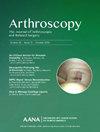基于解剖学的腓骨后外侧角重建与两个股骨隧道显示出最低的外旋和外翻应力残余松弛:体外生物力学研究的系统回顾和网络荟萃分析。
IF 4.4
1区 医学
Q1 ORTHOPEDICS
Arthroscopy-The Journal of Arthroscopic and Related Surgery
Pub Date : 2025-05-01
DOI:10.1016/j.arthro.2024.08.046
引用次数: 0
摘要
目的:对评估后外侧角(PLC)重建技术(包括基于腓骨和胫腓骨的技术)的体外尸体生物力学研究进行系统回顾和网络荟萃分析:在 2023 年 12 月搜索了 PubMed/MEDLINE、Embase 和 Cochrane 图书馆中有关评估 PLC 重建的尸体研究。在进行描述性总结后,进行了一系列频数网络荟萃分析,比较了1)非解剖腓骨型(单股骨隧道)、2)解剖腓骨型(双股骨隧道)和3)解剖胫腓骨型PLC重建与完整膝关节在膝关节屈曲0-90˚范围内的外旋(ER)和内翻松弛情况。采用随机效应模型,以平均差(MD)和95%置信区间(CI)计算汇总治疗估计值:结果:共纳入 31 项研究。基于腓骨的非解剖重建显示,在屈曲 30-90˚ 之间,ER 的松弛程度比完好状态更高(0˚ 的平均差异为 1.66 [95% CI],90˚ 的平均差异为 1.66 [95% CI]):0˚:1.66 [95% CI -0.27-3.59],p=0.093;30˚:2.29 [95% CI 0.44-4.13],p=0.015。60˚:3.04[95%CI 0.95-5.12],p=0.004,90˚:4.30 [95% CI 1.41-7.19],P=0.004)。以解剖腓骨为基础的重建和以胫腓骨为基础的重建(胫腓骨0˚除外)在所有屈曲值下都能恢复ER稳定性。在所有情况下,除了解剖腓骨重建技术在0˚时外(MD 0.85 [95% CI 0.06至1.63],P=0.034),其他三种重建技术都能恢复与完好状态相比的屈曲稳定性。在评估的ER和曲度松弛状态中,基于解剖腓骨的重建在8种情况中的5种被评为 "最佳":结论:采用非解剖腓骨重建技术的PLC重建显示,膝关节屈曲30-90˚的ER残余松弛度增加。相反,基于解剖腓骨和胫腓骨的重建技术在大多数膝关节屈曲值评估中显示出与完整膝关节状态相似的ER和屈曲松弛:临床相关性:PLC重建的技术多种多样,但还没有研究对这些重建技术的生物力学特性进行全面比较。本文章由计算机程序翻译,如有差异,请以英文原文为准。
Anatomic Fibular-Based Posterolateral Corner Reconstruction With 2 Femoral Tunnels Shows Lowest Residual Laxity With External Rotation and Varus Stresses: A Systematic Review and Network Meta-analysis of In Vitro Biomechanical Studies
Purpose
To perform a systematic review and network meta-analysis of in vitro cadaveric, biomechanical studies evaluating described techniques for posterolateral corner (PLC) reconstruction, including fibular- and tibiofibular-based techniques.
Methods
The PubMed/MEDLINE, Embase, and Cochrane Library databases were searched in December 2023 for cadaveric studies evaluating PLC reconstruction. After a descriptive summary, a series of frequentist network meta-analyses comparing (1) nonanatomic fibular-based (single femoral tunnel), (2) anatomic fibular-based (double femoral tunnel), and (3) anatomic tibiofibular-based PLC reconstructions with the intact knee were performed for both external rotation (ER) and varus laxity from 0° to 90° of knee flexion. Pooled treatment estimates were calculated as mean differences (MDs) with 95% confidence intervals (CIs) using random-effects models.
Results
A total of 31 studies were included. Nonanatomic fibular-based reconstructions showed increased ER laxity compared with the intact state between 30° and 90° of flexion (MD, 1.66° [95% CI, –0.27° to 3.59°] at 0° [P = .093]; MD, 2.29° [95% CI, 0.44° to 4.13°] at 30° [P = .015]; MD, 3.04° [95% CI, 0.95° to 5.12°] at 60° [P = .004]; and MD, 4.30° [95% CI, 1.41° to 7.19°] at 90° [P = .004]). The anatomic fibular- and tibiofibular-based reconstructions restored ER stability at all flexion values (except at 0° for tibiofibular based). All 3 reconstructions restored varus stability compared with the intact state in all scenarios except the anatomic fibular-based techniques at 0° (MD, 0.85° [95% CI, 0.06° to 1.63°]; P = .034). Across the assessed ER and varus laxity states, the anatomic fibular-based reconstruction was ranked “best” in 5 of 8 scenarios.
Conclusions
PLC reconstructions using nonanatomic fibular-based techniques showed increased residual laxity in ER from 30° to 90° of knee flexion. Conversely, anatomic fibular- and tibiofibular-based reconstructions showed ER and varus laxity similar to that in the intact knee state across most of the assessed knee flexion values.
Clinical Relevance
Various techniques have been described for PLC reconstruction. However, no study has comprehensively compared the biomechanical properties of these reconstructions with one another.
求助全文
通过发布文献求助,成功后即可免费获取论文全文。
去求助
来源期刊
CiteScore
9.30
自引率
17.00%
发文量
555
审稿时长
58 days
期刊介绍:
Nowhere is minimally invasive surgery explained better than in Arthroscopy, the leading peer-reviewed journal in the field. Every issue enables you to put into perspective the usefulness of the various emerging arthroscopic techniques. The advantages and disadvantages of these methods -- along with their applications in various situations -- are discussed in relation to their efficiency, efficacy and cost benefit. As a special incentive, paid subscribers also receive access to the journal expanded website.

 求助内容:
求助内容: 应助结果提醒方式:
应助结果提醒方式:


